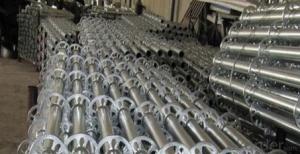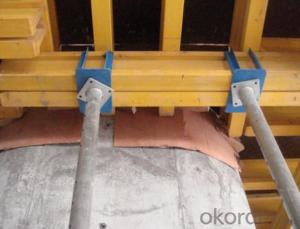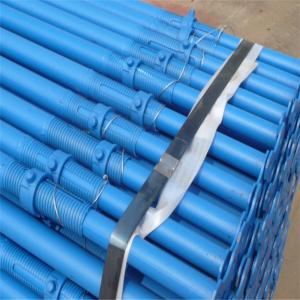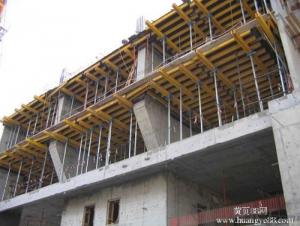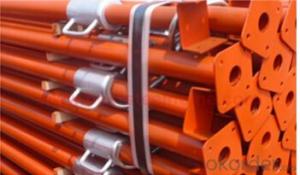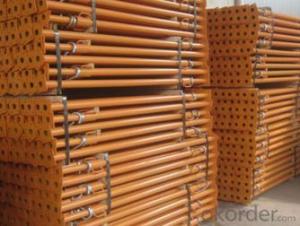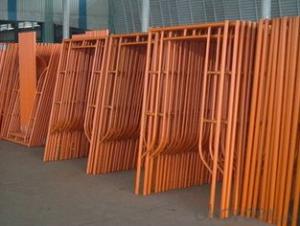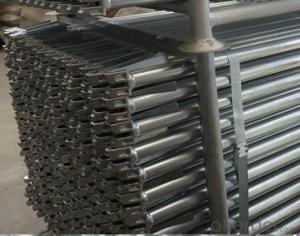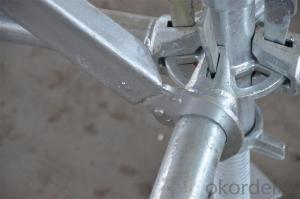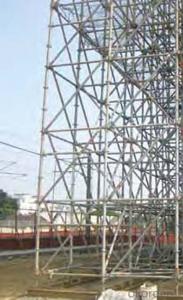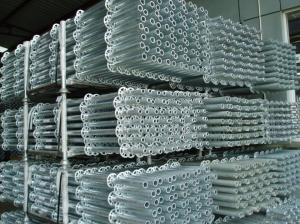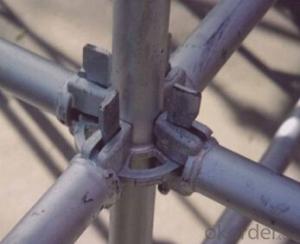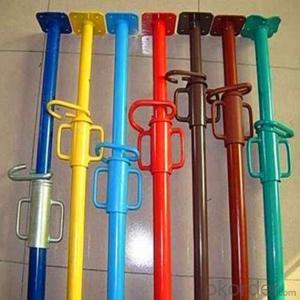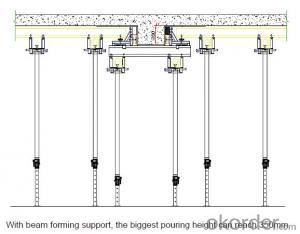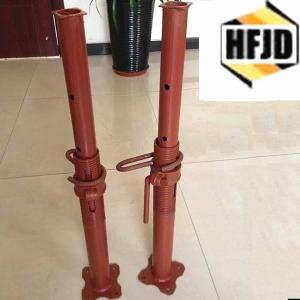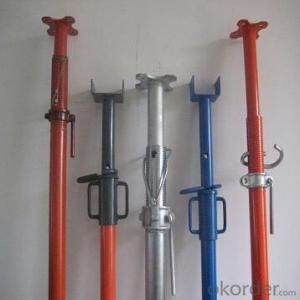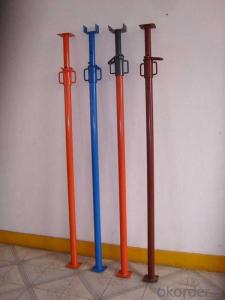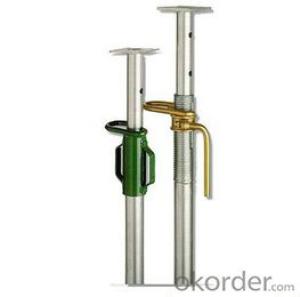Q345 Hot Dipped Galvanized Ringlock Scaffold On Sales
- Loading Port:
- China Main Port
- Payment Terms:
- TT OR LC
- Min Order Qty:
- -
- Supply Capability:
- -
OKorder Service Pledge
OKorder Financial Service
You Might Also Like
Quick Details
| Key word: | Material: | Finish: | |||
| Color Options: | Tube Dia: | Wall Thickness: | |||
| Parts: | Standard: | MOQ: | |||
| OEM: |
Packaging & Delivery
| Packaging Detail: | Bundle Packed With Strong Durable Steel Straped Protected , Which Is Seaworthy |
| Delivery Detail: | 3-4 Weeks Since Payment Arrived To |
Specifications
Ringlock Scaffold
1.Powder Coated , HDG
2. Q235B Q345B
3..Ledger , Standard ,Rosette, Base Collar etc
4. Free Sample
Q345 Hot Dipped Galvanized Ringlock Scaffold On Sales
I. Basic Information:
• Key Word : Ringlock Scaffold
•Surface Finish: Powder Coated , Hot Dipped Galvanized
• Material : Q235B Q345B
• Color Options: Silver ( Galvanized Surface ) Or RAL Colors For Powder Coated
• Pipe Size: 48.3mm
• Pipe Wall Thickness: 2.5mm , 2.75mm, 3.0mm, 3.2mm, 3.25mm, 3.8mm, 4.0mm
• Production Technology : Argon Arc Welding
• Others Accessories: Ledger, Standard( Vertical), Base Collar, Steel Plank, Screw Jack etc
• Loading Information: 25Tons / 20' HQ Conatiner
• Delivery time: Wthin 30 Days From Order Confirmed Date
• MOQ : 1000 Pieces
• Supply ability: 1500 Tons / Month
| Reference | Data |
| Brand | ZhanYe |
| Model | ZY020 |
| Material | Q235B Q345B |
| Surface | Hot Dipped Galvanized, Powder Coated |
| Pipe Dia | 48.3mm |
| Thickness | 2.5mm , 2.75mm, 3.0mm, 3.2mm, 3.25mm, 3.8mm, 4.0mm |
| Parts | Standard( Vertical) , Ledger , Diagonal Brace, Base Collar etc |
| Loading Qty | 25Tons/20'GP |
| Lead Time | Within One Month |
| OEM | Offered |
- Q: What are the potential ergonomics concerns when using steel props?
- When using steel props, there are several potential ergonomics concerns that need to be considered. Firstly, the weight of steel props can be quite significant, especially if they are of a larger size. This can pose a risk of musculoskeletal injuries such as strains and sprains, particularly when lifting or moving the props. Another concern is the awkwardness of handling steel props due to their size and shape. They may require bending or reaching in uncomfortable positions to properly position or secure them, which can lead to discomfort or injury over time. Additionally, the sharp edges or protrusions on steel props can cause cuts or abrasions if not handled carefully. Furthermore, prolonged use of steel props without proper support or padding can lead to pressure points and discomfort, potentially causing issues like pressure sores or nerve compression. It is important to address these ergonomics concerns by implementing appropriate measures. This may include providing training on proper lifting techniques, using mechanical aids or assistance when moving heavy steel props, and ensuring that workers have access to suitable personal protective equipment, such as gloves, to minimize the risk of cuts or abrasions. Additionally, considering the design and materials of the props can help mitigate ergonomics concerns. For instance, using props with ergonomic handles or grips can improve handling and reduce strain on the hands and wrists. Employing props with rounded edges or padding can also minimize the risk of pressure points and discomfort during prolonged use. Overall, being aware of the potential ergonomics concerns when using steel props and taking appropriate measures to address them is crucial for ensuring the safety and well-being of workers.
- Q: Can steel props be used in supporting temporary fencing systems?
- Yes, steel props can be used in supporting temporary fencing systems. Steel props are strong and durable, making them suitable for providing stability and support to temporary fencing installations.
- Q: Are steel props suitable for supporting elevated platforms or decks?
- Yes, steel props are generally suitable for supporting elevated platforms or decks. Steel is a strong and durable material that can withstand heavy loads, making it a reliable choice for providing structural support in such applications. However, it is important to ensure that the props are properly sized and installed according to engineering standards and local building codes to ensure safety and stability.
- Q: How do you determine the number of steel props required for a project?
- Determining the number of steel props required for a project involves considering several factors such as the load-bearing capacity of the props, the height and spacing requirements, and the overall structural design of the project. Firstly, it is important to determine the required load-bearing capacity of the steel props. This can be achieved by calculating the total weight or load that the props will need to support. This can include the weight of any construction materials, equipment, or structures that will be placed on the props. Next, you need to consider the height and spacing requirements of the props. The height will depend on the specific project requirements, such as the height of the ceilings or the number of floors. The spacing between the props will depend on the load distribution and the structural design of the project. Generally, the distance between the props should be such that it evenly distributes the load and provides sufficient stability. It is also important to consider the type and size of the steel props. Different projects may require different types of props, such as adjustable or fixed props, depending on the construction needs. The size of the props will depend on the load-bearing capacity required and the height of the project. To determine the number of steel props required, you can divide the total load by the load-bearing capacity of each prop. This will give you an estimate of the minimum number of props needed. However, it is recommended to add a safety margin to ensure the stability and safety of the structure. This can be done by increasing the number of props or using props with higher load-bearing capacities. Lastly, it is crucial to consult with structural engineers or construction experts who can provide specific calculations and recommendations based on the project's requirements and regulations. They can review the structural design and provide professional guidance on the appropriate number and specifications of steel props needed for the project.
- Q: What is the use of steel, under what circumstances the need to install steel column
- The simple point is that in the original reinforced concrete beams, columns and other components to add steel, steel can effectively improve the bearing capacity of components, reduce the axial compression ratio. Usually more high-level structure.
- Q: How do you ensure the stability of a steel prop on soft ground?
- To guarantee the stability of a steel prop on soft ground, there are various steps that can be taken: 1. Thoroughly evaluate the ground conditions: Before installing the steel prop, it is crucial to conduct a comprehensive assessment of the ground conditions. This involves analyzing the soil type, moisture content, and potential hazards like underground utilities or weak areas. 2. Utilize suitable foundations: To ensure stability, it is essential to employ the appropriate type of foundation for the steel prop. This may involve using concrete footings or steel plates to evenly distribute the load across the soft ground. The size and depth of the foundation will depend on project requirements and the ground's weight-bearing capacity. 3. Enhance the contact area: To minimize the risk of sinking or tilting, increasing the contact area with the ground helps distribute the load more effectively. This can be achieved by incorporating larger base plates or adding supplementary supports like timber planks or steel beams to spread the load. 4. Install additional bracing: In certain cases, additional bracing may be necessary to provide lateral support and prevent the steel prop from shifting or tilting. This can be accomplished by installing diagonal bracing or tie-backs to anchor the prop against external forces. 5. Regularly monitor and maintain: Once the steel prop is in place, it is crucial to regularly monitor its stability, especially if there are any changes in ground conditions or load-bearing requirements. This entails conducting periodic inspections, making adjustments as needed, and ensuring proper maintenance to prevent any deterioration over time. Overall, guaranteeing the stability of a steel prop on soft ground necessitates a combination of thorough assessment, appropriate foundations, increased contact area, additional bracing, and regular monitoring. By implementing these measures, the risk of instability can be minimized, ensuring the safety and effectiveness of the steel prop.
- Q: How do steel props contribute to the overall cost-effectiveness of a project?
- Steel props contribute to the overall cost-effectiveness of a project in several ways. Firstly, steel props are a cost-effective solution for supporting and stabilizing structures during construction. They are versatile and can be easily adjusted to different heights, allowing for efficient use of materials and reducing the need for custom-made supports. Additionally, steel props are durable and have a long lifespan, which means they can be reused multiple times, saving costs on purchasing new supports for each project. This reusability also reduces waste generation, contributing to sustainable construction practices. Furthermore, steel props are lightweight and easy to transport and handle, reducing labor and transportation costs. Their simple and quick installation process saves time and allows for faster construction progress, leading to overall cost savings on labor and project duration. Moreover, steel props provide a safe working environment by ensuring structural stability during construction. By preventing collapses or accidents, they reduce the risk of costly delays, injuries, and damage to the project, thus saving additional expenses. Lastly, steel props can be easily rented or leased from construction equipment suppliers, eliminating the need for large capital investments in purchasing the supports. This flexibility in procurement options allows project managers to allocate their budget more efficiently and invest in other areas of the project. In conclusion, steel props contribute to the overall cost-effectiveness of a project by offering a versatile, durable, and reusable solution for structure support. Their lightweight nature, ease of installation, and safety features further enhance their cost-saving benefits. By considering these factors, project managers can make informed decisions and maximize cost-effectiveness in construction projects.
- Q: Can steel props be used for supporting temporary elevated platforms?
- Yes, steel props can be used for supporting temporary elevated platforms. Steel props are strong and sturdy, making them suitable for providing the necessary support and stability required for elevated platforms.
- Q: Do steel props require regular maintenance?
- Yes, steel props do require regular maintenance. Steel props are used to support structures during construction and they are subject to wear and tear due to the heavy loads they bear. Regular maintenance is necessary to ensure the props remain safe and fully functional. This maintenance may include regular inspections for signs of damage or wear, cleaning to remove dirt and debris, lubrication of moving parts, and replacement of any worn or damaged components. Regular maintenance helps to prolong the lifespan of the steel props and ensures that they can continue to provide reliable support for construction projects.
- Q: How do you prevent steel props from rusting or deteriorating over time?
- To prevent steel props from rusting or deteriorating over time, it is important to implement proper maintenance and protective measures. These can include regular cleaning and drying of the props, applying rust-resistant coatings such as paint or galvanization, and storing them in a dry and well-ventilated area when not in use. Additionally, avoiding exposure to harsh environmental conditions such as moisture, extreme temperatures, and corrosive substances can also help extend the lifespan of steel props.
Send your message to us
Q345 Hot Dipped Galvanized Ringlock Scaffold On Sales
- Loading Port:
- China Main Port
- Payment Terms:
- TT OR LC
- Min Order Qty:
- -
- Supply Capability:
- -
OKorder Service Pledge
OKorder Financial Service
Similar products
Hot products
Hot Searches
